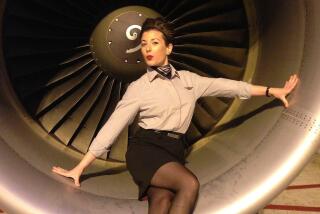Safety in the Air
- Share via
It seems that Sylvie Drake, the Times theater writer, has been completely taken in by a bit of TWA theater. This is not surprising. What is surprising is that The Times would run a piece on TWA written by a layperson. As a flight attendant, I certainly wouldn’t expect The Times to publish a piece I might write about theater, for I don’t know all the details and nuances that are critical in that area. In other words, I know what I like, but I don’t know what’s “good.” In this same sense, Drake knows what she likes about airline flights, but not what’s good--or, in this case, safe.
Did she watch closely during the critical three minutes after takeoff and the eight minutes before landing, those times when most emergencies develop? Was all the safety equipment located, and were all the emergency exits engaged? Were the cabin and emergency centers secured for takeoff and landing?
As her charming “understudies” scanned their cabins, were they wooing the crowds and checking seat belts, or were they also automatically evaluating their cabins: imprinting the locations of children, elderly, handicapped and the most able-bodied and, finally, any suspect passenger who might prove a threat to flight and passenger safety? If, while in flight, there was a lavatory or oven fire, the terror of decompression, a choking child, an epileptic or drug-induced seizure, a noxious drunk or a frightened child traveling alone, what would these TWA actors do? What if there was an anticipated emergency landing?
This is when a professional cabin crew--experienced, not “fresh”--is essential. Believe me, an airline emergency is not like the movie, “Airplane.” It is not theater. It is real and it is terrifying. Experienced and well-trained flight attendants react in these situations automatically, for if they were to pause to think, all could be lost. A burning plane needs to be evacuated within seconds.
As a flight service manager with 17 years of seniority, I’ve encountered every one of the episodes listed, and many more. I’ve never poured a drink with “total engagement.” These are not scenes from a musical comedy about waitresses. Waiting on the public in the air is dramatically different than on the ground. And to prove it, every professional flight attendant has a three-inch-thick emergency handbook that is fully committed to memory, subject to yearly testing by the FAA.
The primary function of a flight attendant is passenger safety. The true artistry is that TWA’s career professionals do that job so well that the safety function is virtually invisible and seems effortless. We’ve enticed you to be obsessed with food, baggage, movies, smiles and conversation. You don’t need to be concerned about safety, because we manage that quite well.
NANCY L. HUBERTH
Information representative
Independent Federation of Flight Attendants
More to Read
The biggest entertainment stories
Get our big stories about Hollywood, film, television, music, arts, culture and more right in your inbox as soon as they publish.
You may occasionally receive promotional content from the Los Angeles Times.










